
If you’re an aspiring professional writer, this question is probably a familiar one:
What if you’re just not good enough?
I’m here to tell you that this question shouldn’t scare you. It should invigorate you. Because all it means is that you’re an artist. To be an artist is to doubt yourself. It’s baked into the cake.
Of course, that doesn’t help you in the moment, when you get word that your script didn’t advance past the first round of a screenplay competition. Or you send your script to a friend for feedback and they tell you, as nicely as possible, that it blows chunks.
In those moments, it’s impossible not to wonder if you’re good enough.
Let me alleviate some of that fear right off the bat.
Almost all doubt is b.s.
If it was real, the second you achieved something, the doubt would stop. It would say to you, “I’m sorry, I was wrong. You’re definitely good enough. My bad.”
When you make the Black List for the first time, you will ask yourself, “Do I belong here?” When you sell your first script for a million dollars, you will ask yourself, “Was it a fluke?” When you get your first big studio credit, you will ask yourself, “Am I an imposter?”
I know a very famous screenwriter, someone who’s arguably in the top 10 most successful screenwriters of the last 30 years – and even he expressed to me that he thinks, “Have I lost touch?” “Do I not know what audiences want anymore?”
I tell you this so that you see doubt for what it really is – a leech that thinks it’s doing you a favor by lowering your expectations so you don’t get upset when something doesn’t go right. You’re an artist. Therefore, you will always doubt yourself on some level and THAT’S OKAY.
What’s not okay is allowing the doubt to control you. Writers, by and large, are introverts. They live in their heads. This is extremely dangerous when things aren’t going well because the writer will start asking the question, “Am I good enough?” And it will loop. “Am I good enough?” “Am I good enough?” “Am I good enough?”
If you don’t put a stop to that loop, perception becomes reality. You aren’t good enough because you’ve convinced yourself you aren’t good enough. And that’s when the true damage sets in. The less you believe in yourself, the less you’ll write. The less you’re writing, the less chance you’ll write the thing that catapults you to the next level.
So while the question, “What if I’m not good enough?” will always be there, it shouldn’t dictate your belief in yourself or your writing output.
I remember resisting starting Scriptshadow because I didn’t think I was a good enough writer. I’d read a million articles in newspapers and magazines and I didn’t think of myself as someone who could match that level of professionalism. I wrote in a sort of goofy informal manner, the exact opposite of what “professional” writers did, and that nearly prevented me from starting the site.
In the end, I tricked myself by labeling the site “non-professional.” If the site itself was non-professional, then I didn’t need to be professional. It did the job and in the intervening years, I learned that professionalism, while important, wasn’t the whole ball of wax. There were other factors that make you a good writer like your writing style, your sense of humor, your ability to entertain, your point-of-view. All of these things could bridge the gaps you have in your writing.
I’m embarrassed to admit that when I started the site, I did not know that you always put quotes AFTER the punctuation. But had I convinced myself that I wasn’t good enough to start the site, I never would’ve learned that and fixed it.
Probably the biggest reason this question comes up is time. When you’ve been writing for a long time and nothing’s come of it, it’s hard to identify any reasons to continue other than blind faith. And while blind faith works for the first couple of years, it seems to depreciate exponentially every year thereafter.
Every rejection seems to reinforce that you weren’t cut out for this line of work. And since most writers don’t have a support network, they eventually fall victim to the negative voice in their head telling them that their pursuit is a waste of time.
But you know what I think?
I think that’s bull$hit.
The reason being: You can always get better.
Always.
There are hundreds of little things in screenwriting you can do that, once you learn, your screenwriting gets better. So as long as you’re constantly making those little 1% improvements here and there, you’re raising your overall ability as a screenwriter.
Maybe you write twenty practice scenes where the only thing you focus on is building conflict into the scene, so that your scene-writing becomes more entertaining. If you do that, you’re going to write lots more conflict-heavy scenes in your scripts, and I guarantee it will make them more entertaining.
Or when you write your next draft, focus on losing one line from every action paragraph. That will ensure your script is more lean, and therefore, faster to read.
Do a deep dive one month where you watch your 20 favorite movie characters and write down what it is about each character that you like so much. Take that research, identify the commonalities between the characters, then start writing protagonists with those qualities into your own scripts so that your main characters are better.
I’ve got 1000 “What I Learneds” on the site. Go through them all and use them as prompts for screenwriting practice. As long as you’re always learning something new each time you write, you’re improving. Therefore, it’s only a matter of time before your writing reaches a professional level.
It’s the writers who keep making the same mistakes, the writers who don’t seek out criticism, who will stay at the same level. And, yes, if you aren’t constantly trying to improve, then you probably will never be “good enough.” The landscape is too competitive not to be improving. Luckily, improvement is within your control.
I tell writers all the time during a consult: “This is what you’re doing wrong.” I’m very clear about it because I’ve found, over the years, that if I sugarcoat it, they don’t think it’s as big of a deal as it is. So I make it clear: don’t do this anymore. Yet they come back to me with another script a year later and they’re making the exact same mistake.
For example, they’ll be very obvious and clumsy when writing exposition. So I’ll go through the exposition and explain why it’s clumsy. I’ll explain how to write it so it isn’t clumsy. And yet, when the next script shows up, I see clumsy exposition again.
I understand that we don’t always grasp concepts the first time we hear them. But for a lot of aspiring writers, there seems to be an, almost, willful ignorance about these concepts. They either don’t think they’re as big of a problem as they are or they think that they’re special somehow, and that this particular issue doesn’t apply to them.
I know writers on this site who I want to shake and scream, “YOU KEEP MAKING THIS SAME MISTAKE! YOUR WRITING WOULD BE SO MUCH BETTER IF YOU JUST CHANGED THIS ONE THING!” For some of these writers, I’ve told them this! And yet the same mistakes are still there. And it baffles me. Cause I’ve led you to water. But you still have to be the one to drink.
What I’m saying is, any question regarding whether you’re good enough or not, is usually self-inflicted. You can have the goods if you’re willing to do the work. But if you’re stubborn, if you think your way is the only way, if you’re ignorant, if you don’t think it’s as big of a deal as I do, if you don’t have an “improvement” mindset – you’re going to be stuck in that “almost-pro” tier forever.
And I already know some users will decry this and say success still comes down to those who get lucky. Look, luck plays a part in everyone’s life. But luck favors the people who are ready for the luck to strike them. It doesn’t operate randomly. If some producer is reading Scriptshadow and sees an Amateur Showdown script that they decide to read a few pages of — that producer is not going to buy the script just because. They’re going to buy it because the script is good. And the script was good because the writer did the hard work, kept improving, until their writing was at a professional level.
What I’m saying is, you are good enough.
I truly believe that.
Outside of a tiny percentage of people who don’t have any sort of knack for writing, you are good enough. But you have to be constantly improving if you’re to have any chance at success. So please, always be seeking criticism. You need to know what your weaknesses are so you can fix them. Always be improving some aspect of your writing. Always be open to there being a better way than the way you’re doing it now.
There’s no way you can’t get to the top if you’re always improving. Period. The only way you won’t get there is if you stop. And 99% of writers either stop writing or stop trying to improve. Don’t let that be you.
Happy writing this weekend!
$150 OFF A SCRIPTSHADOW SCREENPLAY CONSULTATION! – To the first person who e-mails me at carsonreeves1@gmail.com with the subject line: “150.” I have a 4 page notes package or a more detailed 8 page option designed to both fix your script and improve your writing. I also give feedback on loglines (just $25!), outlines, synopses, first acts, or any aspect of screenwriting you need help with. This includes Zoom calls discussing anything from talking through your script to getting advice on how to break into the industry. If you’re interested, e-mail me at carsonreeves1@gmail.com and let’s set something up!
Genre: Period
Premise: The true story of the first and only African Samurai in feudal Japan who rose from being a slave for the Jesuits to fighting as a Samurai in the unification of Japan.
About: Screenwriter Stuart Paul sold this project to MGM back in 2019. He also sold a spec around that time called “Terminal Point,” to Universal. Don’t know what that one’s about but the title sounds cool so if you’ve got it, send it my way!
Writer: Stuart Paul
Details: 121 pages
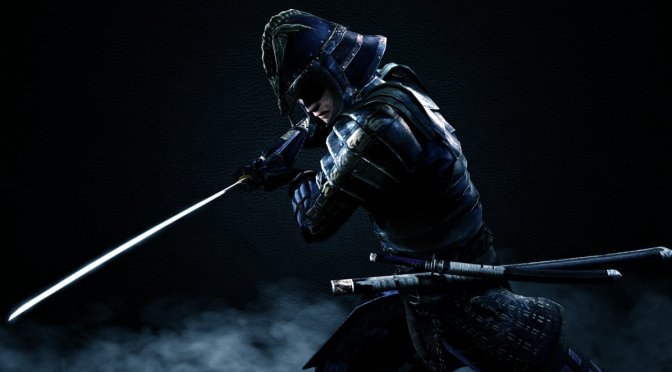
Period pieces.
What happened to them!?
They used to be a Hollywood staple.
I’m guessing it’s Marvel’s fault. I mean, samurais used to be bada$$, right?! These days? They’re superheroes without powers. And who wants that?
Not to mention, period pieces require patience in a world that no longer has any. So that might be why it’s so hard to push these through the system these days. Let’s see if Stuart Paul’s period piece is good enough to get made.
It is the late 1500s. Iosufe, 25 years old, is minding his own business in his home country of Mozambique when Portuguese warriors swoop into his village and brutally slaughter everyone, including his two children. Iosufe is then separated from his wife and thrown on a boat, sent to far off lands to be a slave.
Eventually, he meets Valignano, a Spanish aristocrat who is spreading the word of God across the world. Valignano has never seen a man as enormous as Iosufe, and so makes him a de facto bodyguard. Through Valignano, Iosufe starts to become educated and cultured.
After many months, the two hop on a boat to the Far East. The last place to conquer for Christianity is Japan, so Valignano sails there and begins his mission. The only problem is that there’s this guy named Nobunaga who is trying to take Japan from the current Emperor. And if he becomes Emperor, he will likely put an end to Christianity.
So Valignano and Iosufe travel to his city to negotiate with him. When Nobunaga sees the physical specimen that is Iosufe, he becomes obsessed with him. Seeing this, Valignano gifts Iosufe to Nobunaga in the hopes of gaining political favor from him. For the time being, at least, Nobunaga promises not to take over Japan.
Nobunaga immediately calls for Iosufe to be trained in the ways of the samurai, something the rest of the samurai aren’t so keen on. But after several trials, Iosufe, who Nobunaga renames, “Yasuke,” (meaning, “Idiot”), becomes a samurai.
Nobunaga then brings his army to the last major opponent between him and the Emperor, where Yasuke proves his worth by leading the charge and taking over the city. But after he learns that the women and children of the village will be slaughtered, and he will lead it, he must ask the question, has he become the very man who destroyed his own life? With renewed purpose, he plans his escape in the hopes of finding his wife and reuniting with her.
When you write a script like this, there are two things you must get right.
- There must be sophistication to your writing.
- You must be entertaining.
By sophistication I mean you must have a deep knowledge of the subject matter. You must write with specificity. You must write with discipline. The dialogue has to sound like people speaking back during that time. And there’s no room for messiness. Yesterday’s script, the Michael Bay comedy biopic, had endless room for messiness. These scripts don’t tolerate it, though. They must possess a novel-like attention-to-detail.
Ironically, if a writer can excel at the first thing, they tend not to excel at the second one (write entertainingly). This is because the writers drawn to this subject matter prioritize authenticity so heavily that they forget it doesn’t matter unless the script is entertaining. They’d rather accurately describe the architecture of Rome than write a baller conflict-heavy dialogue scene between the hero and the villain.
Yasuke gets an 8 out of 10 in the sophistication department and a 6 out of 10 in the entertainment department. Which averages out to a solid 7 out of 10.
On the plus side, the writer gets the main character right. It’s hard not to root for someone whose kids are brutally murdered in front of him (and when I say brutally, I mean brutally), whose wive is taken away from him, and who becomes a slave. I mean, if you’re not rooting for Yasuke, there’s something wrong with you.
But then the script runs into a unique problem. Our main character has zero agency over his journey. He’s a slave. So he’s not making any decisions. He’s not being active. He’s just following others around and doing what they say. This makes for a frustrating reading experience because whenever a big moment arrives, it’s whoever’s leading Yasuke that makes the decision, while Yasuke just stands there and nods.
I suppose the argument against this is, “Well, he’s a slave. Slaves can’t lead or it would defeat the point.” I understand that. But then you have to ask, was it the right call to write the script in the first place? Cause it was you who wrote a movie where your hero’s situation necessitated that they stay passive the whole time.
It’s not that Yasuke doesn’t have some great moments in this. He does. Heck, he fights a ninja. And he has this killer sword battle with his rival at the end. But these moments combine to make up, maybe, 7% of the movie. The other 93%, Yasuke is standing around, either watching or listening to people more decorated than him make decisions.
The script still does a lot of things well. One of the issues I commonly run into in scripts with tribes is that we’ll start the movie off with a hunt. The characters, and our hero, then kill the animal they’re hunting. A good portion of your audience isn’t going to love meeting your hero as an animal killer. Some people don’t care about this, obviously. But it’s dangerous in the sense that the audience is forming the majority of their opinion about your hero during their opening scenes. So if you want to make that character likable, you have to take that into consideration.
“Yasuke” had a clever solution to this. They had a lion kill a bunch of Yasuke’s cattle. So, now, when Yasuke and his tribe went off to kill the lion, they’re not just killing an animal for sport or food, they’re killing it for revenge. I noticed how much more I was rooting for them to take down the lion for that reason. So they showed how capable our hero was on a hunt, all without making him barbaric or heartless.
The writer also does a good job of keeping the plot going despite an elongated time frame of 5 years. The trick with this is to keep introducing goals.
-Now we have to go to Japan.
-Now we have to start a church.
-Now we have to convince the Emperor’s rival not to attack him.
-Now we have to take down Nobunaga’s rival.
The plot always had purpose. And as soon as one goal was reached, it was replaced with another. When readers complain about a “lack of momentum” or “weak pacing,” this is often what they are talking about. Writers aren’t staying on top of their hero’s goals.
The script reminds me a bit of that old Tom Cruise movie, The Last Samurai. It has just enough going on to keep us invested. But, in the end, it still feels like a movie you should see and not one that you want to see. It’ll make a great trailer. But I’d put the ceiling at ‘worth the read.’
[ ] What the hell did I just read?
[ ] wasn’t for me
[x] worth the read
[ ] impressive
[ ] genius
What I learned: The gap between your hero’s last accomplished goal and announcement of his next goal is where boredom gestates. So if Yasuke’s goal is to kill a rival bad guy, and he goes and kills him, that character goal has now concluded. Let’s say the next character goal is to escape Nobunaga. If you wait 15 pages after Yasuke killed Rival Bad Guy to announce that he plans to escape Nobunaga, your script will have 15 pages of stasis. You are not moving forward. You are staying in place. Stasis is where boredom sets in. So try to eliminate any of these gaps in your script.
Genre: Comedy
Premise: (from Black List) Packed with enough C4 to split an asteroid in two, this tell-all Michael Bay origin story reveals the explosions that defined him, the fire that ignited his little heart, and the fate that sealed his Hollywood destiny.
About: This writer’s name may sound familiar as I’ve reviewed one other script of his on the site. That one was called Super Dad. Here’s the logline: A subversive superhero story about the world’s only superhero living a bachelor lifestyle, learning he has two very different teenage twins he never knew existed, and now has to figure out how to be a father.
Writer: Sean Tidwell
Details: 91 pages
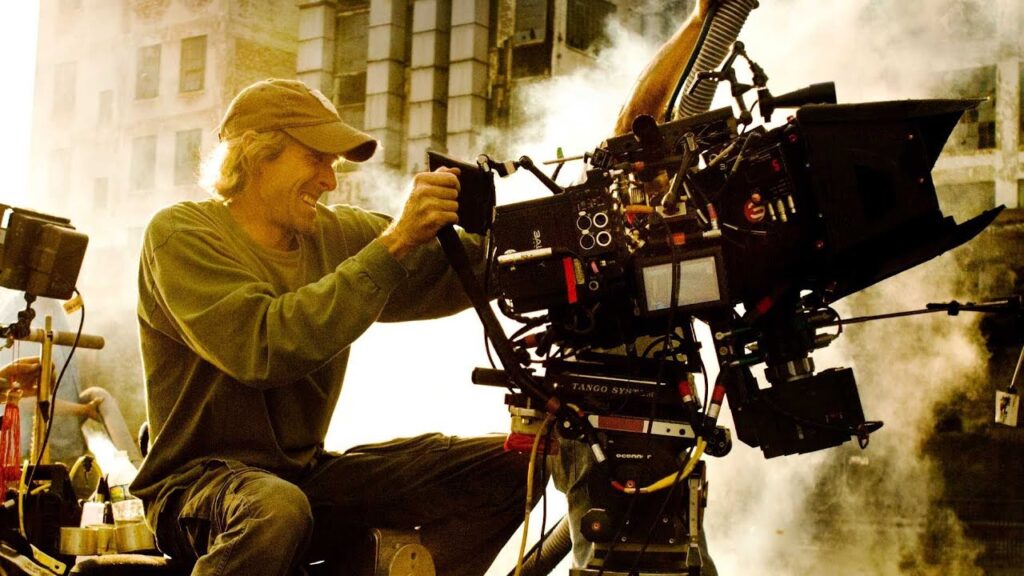
I’m happy to see that they still put stuff like this on the Black List.
Good clean goofy entertainment. Not a single message to be found.
With that said, there is a bigger lesson to be learned here, which is that, if you do want to send a message out, it’s more effective to do it through comedy.
There are probably 50,000 dissertations on the internet about how terrible a director Michael Bay is. How he doesn’t care about story. He’s obsessed with explosions. He keeps making the same movie and over again.
But if you’re angrily stomping your feet in an attempt to get that point across to others, it’ll barely make a dent.
It’s much more effective to do what Tidwell has done with this script. Which is to comically show how ridiculous Michael Bay is. If there’s anything that came out of this script, it was that.
With that said, the comedy is so insanely broad, it takes a certain juvenile attitude to enjoy it. I mean, at one point, Michael Bay, at 10 years old, tries to kill his teacher with a makeshift flamethrower.
And we also get moments like this, which occurs after Michael Bay inadvertently drops acid…
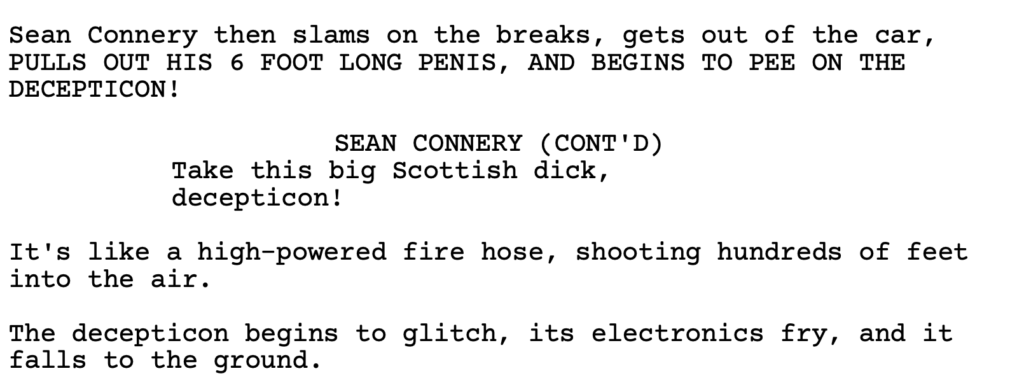
Maybe the most interesting creative choice in today’s biopic was to focus solely on our subject at 10 years old. That’s when we meet Michael Bay, flying a kite, eagerly awaiting his imprisoned father, who’s flying into town along with 150 other prisoners. Michael is so excited to see his father’s plane approaching, he accidentally lets go of his kite, which zips up and gets lodged in the plane’s engine, blowing it up, crashing the plane, and killing everyone on board.
Michael’s mom is so mad that he killed his father, she disowns him, forcing Michael into an orphanage. From there, Michael somehow finds himself filming a wedding, where he accidentally knocks over a candle, starting a fire and killing everyone at the wedding. When the news plays Michael’s footage, an aspiring filmmaker named Steven Spielburger recognizes Michael’s insane filmmaking talent and adopts him.
Steven then sets about teaching Michael how to be a director. He teaches him how to act (by robbing a bank). He teaches him about wardrobe (by breaking into Macy’s and stealing clothes). And he teaches him how to man a camera (by making him walk across a tightrope above a canyon while filming).
As this is happening, Michael must fight his pyromaniac urges and his desire to blow up as many things as possible. He must also avoid the mob, who’s mad at him because the mob boss’s father was on that Con Air flight he accidentally blew up. But Michael is about to learn some shocking news about his new father, news that threatens to destroy his filmmaking apprenticeship and his love of the perfectly lit shot… forever.
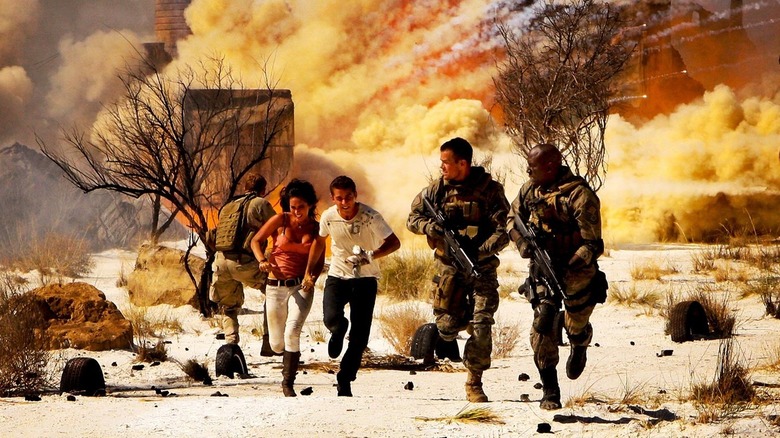
“Michael Bay” definitely brings its share of lols. I particularly liked a lot of the dialogue exchanges. After a 10 year-old Michael Bay attacks his teacher with a makeshift flamethrower and gets sent to the principal’s office, the principal tells his mom. “This is the third fire incident this week.” The school counselor follows up with, “And it’s only Monday.”
Or after Michael Bay killed everybody at the wedding recession by starting a fire and was being arranged in court. The prosecuting victim says, “Judge, this boy’s carelessness killed 30 of my friends!” “Anything else?” “He mouths off, too!” “He mouths off? Jesus.”
Or, when Steven is trying to get Michael to cross the valley while carrying a heavy camera on a tightrope, Michael says, “But. But I’ll die.” Steven responds with, “Boy. Have you looked in the mirror? You’re already dead.” Just imagining that line delivered to a 10 year old boy had me on the floor laughing.
If I had a complaint, it would be that this is the loosest broadest comedy I’ve read all year. The story is never grounded. Sometimes we were so far off the ground we might as well have been in space. But then I started wondering, “Is that the point?”
It seems ridiculous (and kind of barbaric) to kill off 30 innocent people in a fiery death. But maybe this was Tidwell’s subversive commentary on how little Bay respects human life in his own films. It’s meta to the max. The thing is, the script is so wild that it’s hard to make yourself believe that any commentary is actually being done.
Another problem I had was the whole Steven Spielburger character. At first I thought it was supposed to be Steven Spielberg in disguise and we were going to learn that he was secretly Michael Bay’s mentor before something terrible happened that broke them up. But then I realized he was just some random guy named Steven Spielburger. It didn’t make a lot of sense, even in the context of a wild comedy. There were these random references to Steven Spielberg movies as well and all I could think was, “But we’ve established this is just a random guy, lol. Why are we making Spielberg movie references in a Michael Bay biopic?” I couldn’t figure it out.
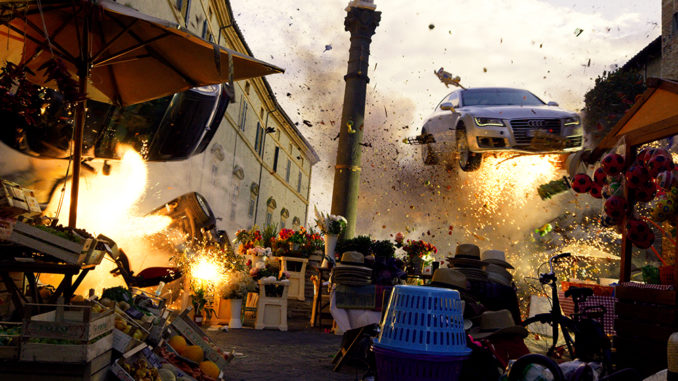
A somewhat smaller issue is that Michael Bay movies aren’t very memorable. At least in my opinion. So there were a bunch of moments here that I assumed were references to Michael Bay movies but because Michael Bay movies are like popcorn – they’re in and out of your system in a day – I didn’t recognize them.
Take the opening shot with a kid flying a kite. I vaguely remember a famous kite shot in a Michael Bay movie. Maybe Pearl Harbor? Armageddon? Or we meet this crack dealer named Mike Lowrey who Michael has a fleeting friendship with. At the end of their friendship, Michael promises to make a movie called Bad Boys and name one of the characters after him.
I had zero idea that a character in Bad Boys was named Mike Lowrey. 99% of the people on the planet know those two characters as Will Smith and Martin Lawrence. I guess there are Bay enthusiasts out there who will fight me on the memorability factor of a Bay movie but, if I’m being honest, the scene I remember more than any other scene from his movies was the animal cracker scene in Armageddon. And not for the right reasons.
This script is light and airy fun. I did laugh. In the end, though, it was too loosey-goosey for my taste. A comedy script should feel effortless. But it should not feel like the writer didn’t put in their full effort. I kinda got the feeling that this script was written in under two weeks which is why it doesn’t hit a ‘worth the read’ for me.
[ ] What the hell did I just read?
[x] wasn’t for me
[ ] worth the read
[ ] impressive
[ ] genius
What I learned: I am begging -BEGGING – comedy writers to stop using acid trips in their comedy scripts. They are in literally 7 out of every 10 comedy scripts I read. In general, I believe all writers should tattoo the phrase, “I’m not as original as I think I am,” to their foreheads and then, every thirty minutes while in a writing session, go look in the mirror, just to remind yourself that, yes, something like an acid trip would be funny, but if the guy that reads your comedy script has read an acid trip in the last five comedy scripts he’s covered, you’re going to look unoriginal. It’s better to push yourself and come up with that scene that nobody else has yet.
Genre: Action/Vampire/Comedy
Premise: A family man uses the cover of being a pool cleaner in Los Angeles to hunt vampires.
About: Netflix is trying to recreate some John Wick magic. They’re going with the new industry trend of hiring a high profile stunt coordinator to direct. Put a B-level movie star in the lead role. Throw in a little mythology. And hopefully create something great. The film debuted on the streamer this weekend. Not surprisingly, John Wick alum Chad Stahlenski produced the film. He brought along young screenwriting superstar, Shay Hatten (who I’m guessing, with how many jobs he’s gotten over the last two years, is a billionaire at this point), to bump up the dialogue for an original script by first time screenwriter, Tyler Tice.
Writer: Tyler Tice & Shay Hatten
Details: 115 minutes
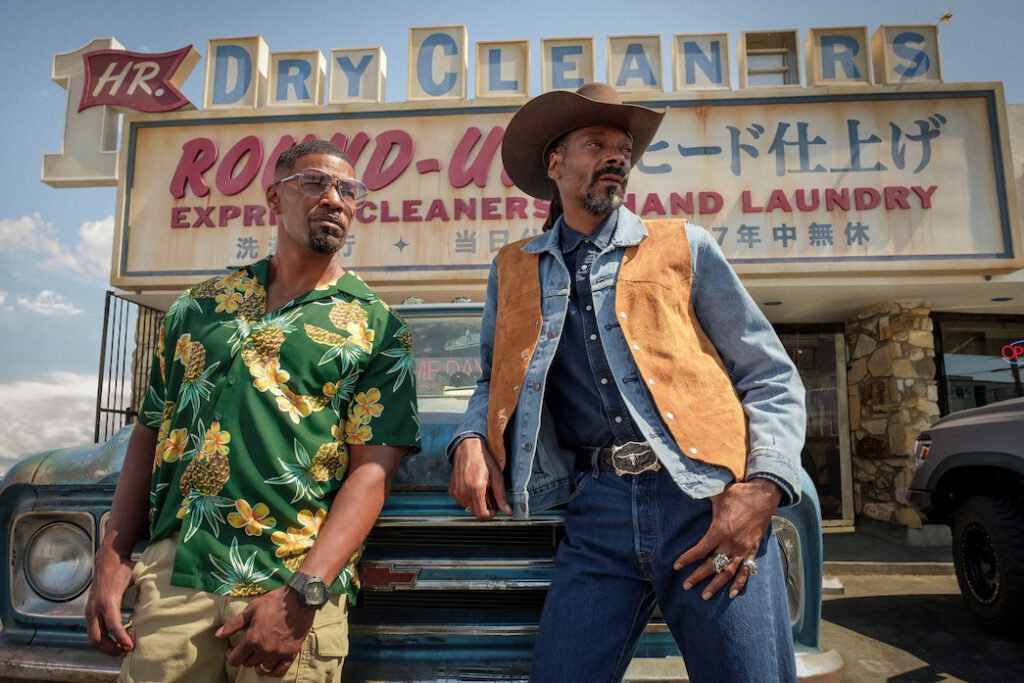
Day Shift is one of those scripts that comes across your desk and you think, “This is a movie.”
For those of you who wonder what I mean by that, a movie is something that can be marketed. That has a legitimate chance of being watched by a lot of people and therefore make money. It must feel larger than life. It must have high stakes. Two people on a road trip in Alaska – that’s not a movie. That’s a screenplay. Even if you were to make that movie – and sometimes they do turn scripts like that into movies – it’s still a screenplay at heart.
When you’ve got a pool cleaner who secretly kills vampires for a living? You’ve got a legit movie.
So when I saw this trailer pop up, I thought, “This is the perfect example of the kind of script you should be writing if you want to sell a screenplay.”
But there’s a weird thing about spec script subject matter that I’ve never quite been able to reconcile. Some of the things that help it become a movie are also, ironically, what sink it as a movie.
The main issue boils down to not having anything figured out beyond the marketable aspect of the script. The emperor has no clothes. Heck, he doesn’t even have underwear. That’s the feeling I got while watching Day Shift.
Day Shift follows 30-something, Bud, who lives in the San Fernando valley, and works as a pool cleaner, something his wife is none too thrilled about since they’re barely able to pay the mortgage and feed their 8 year old daughter. So Bud is feeling the heat to pick up the financial slack.
The thing is, Bud doesn’t really clean pools. He cleans the clocks of vampires. As in kills them. The pools are cover. He sneaks into the backyards of vampire home owners, pretends to do a little cleaning, then SHAZOW! He’s putting a silver bullet through your head. Or whatever they use to kill vampires. A wooden stake or something.
He then takes their fangs and sells them on the black market. The more prestigious the vampire fang, the more money he gets.
What Bud doesn’t know is that the last vampire he killed was some special vampire so now the vampire elite is after him. This forces Bud to re-join the “union” of vampire killers, where he’s paired up, “The Other Guys”-style, with a nerdy union accountant, Seth, and the two try to kill more vampires as well as avoid the elite vampires. Shenanigans galore follow.
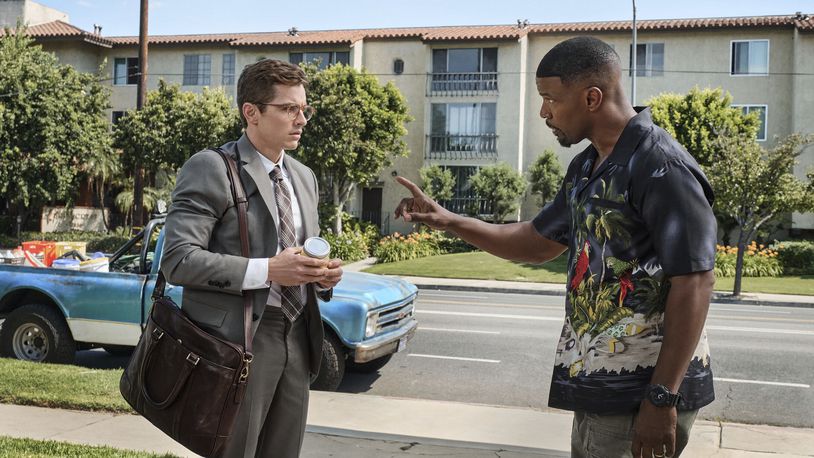
Just to remind everyone, we have a HIGH CONCEPT SHOWDOWN coming up in December. So I hope you’re writing your high concept scripts as we speak. Day Shift would definitely fall under the ‘high concept’ category.
What: AMATEUR SHOWDOWN – HIGH CONCEPT EDITION
When: Entries due December 1 by 8pm Pacific Time
How: E-mail me your title, genre, logline, any extra pitch you want to make about why your script deserves a shot, and, of course, a PDF of the screenplay.
Where: carsonreeves3@gmail.com
Anything else?: You can start sending in your scripts right now!
But the script is a reminder that coming up with a high concept is half the battle. You then have to actually write 100 pages of story that execute that concept in an entertaining way. And what I’ve found is that a lot of writers feel like they did the hard work already by coming up with the concept and therefore half-a$$ the creative choices throughout the script.
Those choices in Day Shift were often fine, mind you. But no reader or audience member in history has ever gotten excited about “fine.” In my book, fine is worse than “bad.” Because at least bad creates some emotion, albeit negative. Fine doesn’t create any emotion at all. Everything about this movie was fine.
Take, for example, the creative choice of the “union.” It doesn’t fit into the movie. It feels forced. The mythology underneath it is not strong enough to support the choice. It just feels like it’s there because another movie did it and, so, maybe it’ll work in our movie too.
Never EVER think that way as a writer. Don’t do what other movies do. Other movies have their own set of problems. Your movie has it own culture, its own unique set of circumstances. So make decisions that are best for your movie only. I mean give me a break. You’ve got a Men In Black like secret organization for vampire killing. It was a dumb idea.
This movie works so much better if killing vampires is an informal thing. It’s fine if there’s a bigger network but the second you have this Steve Spielberg like organization, it took a gritty gnarly crazy cool job and buttoned it up. It made it lame.
I get that it gives us Seth. And Seth is, arguably, the best part of the movie. Especially (spoiler) when he turns into a vampire himself (which was the lone strong creative choice in the script). But there were other ways to team Bud up with a character like Seth that didn’t require some stupid underground organization that doesn’t feel like it has anything to do with your movie.
Another big issue with the film was that the main character was boring. And he shouldn’t have been. Tice and Hatten did everything you were supposed to do in creating Bud. He’s a poor guy trying to support his family who loves his daughter more than anything. Why aren’t we rooting for this guy?
This is the kind of stuff that keeps me up at night. I’m not joking. I go to sleep wondering why some of these characters work and others don’t despite both following the same playbook. Bud is clearly likable. He’s a selfless person who wants to make a good life for his daughter. Why doesn’t he work?
The conclusion I came to was that he’s boring. A character still has to be a person. They can’t just be a combination of correct screenwriting choices. Save the cat. Be a nice human being. Care for a weaker character. Sure, those help. But your character still needs a unique likable personality. They need to feel like their own person. Bud doesn’t feel like anyone. He’s more vanilla than my Muscle Milk protein powder.
So remember that. Separate from the “likable traits,” make sure your protagonist has their own unique personality.
This is not a terrible movie. It’s just a forgettable one. Which is disappointing because I was hoping for more.
[ ] What the hell did I just read?
[x] wasn’t for me
[ ] worth the read
[ ] impressive
[ ] genius
What I learned: Figure out who your characters are by asking ,“What would their ringtone be?” Seth is a nerdy by-the-book sorta douchebag. The reason his ringtone – Nicleback – is one of the funnier moments in the movie is because it perfectly encapsulated him. So when you’re trying to figure out what kind of funny a character in your screenplay is, ask yourself, “What would their ringtone be?” We don’t have to ever hear it in the film. But you should personally know it. By doing so, you’ll have a better feel for how to write that character.
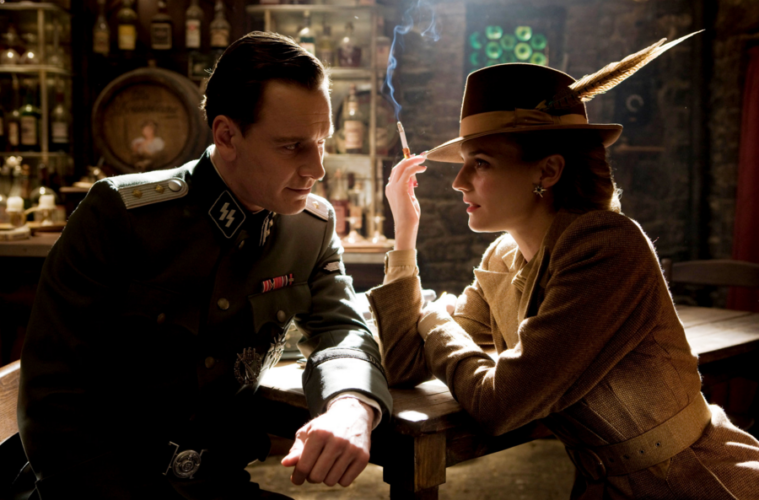
Someone once said that the key to becoming successful in life is mastering the ability to delay instant gratification for long-term benefit.
In other words, if someone handed you 100 bucks, would you spend it all right now? Buy that video game you’ve been jonezing to play? Celebrate with a wild night out of drinking? Head over to farfetch.com and snag that fly pink polo you know you’d look great in?
Or do you put it in a savings account, let it accumulate interest over the years with all the rest of the money you’ve strategically saved, so that when it comes time to buy a house, or send your kids to college, you have more than enough in the bank?
I think there are benefits to both options. Sure, if you spend the money now, you don’t have it in the future. But in a world where happy memories are, arguably, more valuable than anything else, including money, who’s to say that spending that money today on a good time is a bad idea?
With that said, being 60 and broke ain’t the coolest thing either.
This debate is not limited to money. Do you do a fun low-paying job now as opposed to a boring high paying job that will set you up for later? Do you date the young crazy-fun partner now or do you find a mate who, while not as exciting, is more stable and good for you in the long run? These aren’t the easiest questions to answer.
You’re probably wondering why I’m bringing this up.
It’s because writing a screenplay brings up a similar dilemma. Do you try and write the best possible story for the moment, always keeping the script exciting on every page, knowing that you risk the screenplay burning out? Or do you stoke a reserved fire and pace yourself in the hopes that the larger story experience is more rewarding?
To answer this question, I want to talk about two screenplays I’ve read over the years.
The first is one I read a few years ago. The script was a sort of Quentin Tarantino inspired story that involved over-exaggerated characters and a lot of dialogue. And it was GREAT. The characters were all fun. The scenes were long with lots of tension-filled dialogue. It was a really enjoyable read.
What made this particular script such a shocking discovery was that the writer had sent me another script five years earlier and I had privately labeled it one of the worst scripts I’d ever read. It was a quasi biopic comedy about a famous person that, to be frank, was more boring than waiting for water to boil.
When I found out that the same writer had written both scripts, I had to know what he did with the latest script that he hadn’t done with the earlier one. And his answer surprised me. He said that with the first script, he’d carefully mapped out the story and was trying to weave a theme in there and write a traditional three-act movie. But with the second script, he hadn’t even intended to write a movie. Instead, he wanted to practice his scene-writing and write a series of scenes that were entertaining on their own.
He wrote four or five of these scenes before he realized, maybe I can connect these and turn them into a movie. However, even after he started connecting the scenes, he still wrote the rest of the script in the same fashion – just trying to write great scenes.
I was fascinated by this answer because what he was effectively saying was that, with this script, all he was trying to do was write a compelling scene in the moment. He was trying to entertain the reader immediately, with no plans of making a larger story work. He was the equivalent of the guy who spent his 100 dollars right away.
I didn’t put too much stock into this at first. Cause the way I saw it, this was a writer who’d had five more years to get better since his previous screenplay. Maybe he just got much better at writing in general and would’ve written a good script regardless of how he approached it.
But then, around a year later, a producer asked me if Tyler Marceca’s “The Disciple Program” was available cause he wanted to see if he could buy the rights and do something with it.
This got me thinking about The Disciple Program and I remembered the circumstances by which the script was written. It was written for a screenwriting contest (I think it was First Draft’s contest) and they had a very unique contest structure. Each week, you would send in 10 pages of your screenplay and a contest reader would give you notes on those pages to help you craft the next 10 pages. And then the next 10 pages. And so on and so forth.

What this did was force Tyler to only focus on making the current 10 pages as good as possible. Because he couldn’t, for example, write some slower setup scene that was going to get paid off on page 75. There was no reward to setting something up that the reader wouldn’t be able to read for another 8 weeks. So instead, Tyler focused on writing 10 really freaking exciting pages. And then 10 more exciting pages. And then 10 more exciting pages.
He basically wrote a series of ten really exciting 10-page segments.
Naturally, you can see the connection here. Just like the Quentin Tarantino writer, Tyler was focusing on entertaining the reader here and now as opposed to carefully crafting a longer, more deliberate, story.
I think you guys know where I’m going with this.
I’m a believer that you should spend that 100 dollars every 10 pages, instead of saving it all for your climax.
Obviously, there are challenges to this approach. Such as maintaining momentum when every section of your script has to be great. But it’s doable. Tyler’s script was a non-stop action ride. But the first script I mentioned was almost entirely dialogue. The writer just knew how to build up conversations in an exciting tension-filled way. For example, we’d know going into a scene, that Character 1 was planning to kill Character 2, but Character 2 didn’t know that. So there was dramatic irony and tension building during their conversation as we eagerly anticipated the attempted assassination.
And this is not to say you should throw out any pre-construction of your story. I’m not saying never plan your screenplay again.
But this approach does necessitate you do more organization on the back end. The idea is that you write for the moment all the way through your first draft. And then, once you see what you have, you use subsequent drafts to pull all those separate pieces together.
Can EVERY screenplay be written like this? I don’t know but I suspect not. For example, I don’t think you can take something like Lord of the Rings – which has an immense amount of backstory and exposition that needs to be conveyed – and just try to write that in the moment. Movies like that need more planning.
But I do think this strategy can work for most screenplays. And it has a precedent for working. I’m a big believer in The Sequence Approach, which is the process of breaking your screenplay down into eight mini-movies and trying to write eight of the best mini-movies you can. This 10-page approach just tightens that up a bit. Eight sequences in a 110 page script amounts to roughly 13.5 pages each. So you’re cutting that down by 3.5 pages to 10 pages each.
And just to be clear, there are no hard-and-fast rules here. If one of your sequences is 8 pages and the next is 12, that’s fine. The main thing is you’re writing for the here and now. You’re writing roughly 10 pages where your only objective is to make those pages impossible to put down. Put yourself in the reader’s head. Could they be bored by this? If the answer is yes, erase, go back to where it started getting boring, and write something better.
Keep in mind also that you’re writing a SPEC SCRIPT. A spec script does not operate by the same rules as a greenlit Hollywood movie. A greenlit Hollywood movie has the script written in-house. They can have a couple of slow-moving scenes because nobody’s judging the script. They’re all working together. When you’re writing on spec, you’re not working for anyone yet. You’re trying to write something good enough so that Hollywood will allow you to work for someone. For that reason, your script has to be more consistently entertaining than a Hollywood movie. I know it’s not fair but those are the rules, bub.
If you’re curious about what script did this better than any script I’ve ever read, look no further than Source Code. If you only ever saw Source Code the movie, you may think that’s a bold statement. But that original script was pretty much designed to be written the way I’m talking about today. So check it out…
Link: Source Code Original Draft!
By the way, you can still plan your story ahead of time. This is not an excuse to never outline. But when you sit down and write, you need to prioritize entertainment over everything else. If it comes down to you following your outline but your outline idea for the scene is boring? You need to throw away your outline and write something the reader can’t put down. That’s what Tyler did. That’s what the Tarantino writer did. That’s what Ben Ripley (Source Code) did. And that method produced three great screenplays. Why shouldn’t you take advantage of this approach as well?
Are you looking for help on your latest screenplay? – Let someone who’s read over 10,000 scripts help you. I have a 4 page notes package or a more detailed 8 page option designed to both fix your script and improve your writing. I also give feedback on loglines (just $25!), outlines, synopses, first acts, or any aspect of screenwriting you need help with. This includes Zoom calls discussing anything from talking through your script to getting advice on how to break into the industry. If you’re interested, e-mail me at carsonreeves1@gmail.com and let’s set something up!

